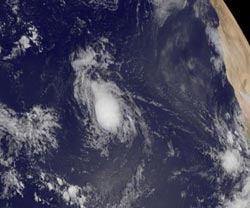NASA sees newborn Tropical Storm Joyce in the Central Atlantic

This visible image of Tropical Storm Joyce was captured by NOAA's GOES-13 satellite on Aug. 23 at 7:45 a.m. EDT. Credit: NASA GOES Project<br>
When NOAA's GOES-13 satellite captured an image of Tropical Depression 10 (TD10) on Aug. 23 at 7:45 a.m. EDT it appeared to have a well-rounded circulation. Infrared imagery indicated cold cloud top temperatures. Cold cloud top temperatures as cold as -63 Fahrenheit (-52 Celsius) show strength in the uplift of air that helps create strong thunderstorms that make up the tropical cyclone. The GOES-13 image was created using the NOAA satellite data at NASA's GOES Project, located at NASA's Goddard Space Flight Center in Greenbelt, Md.
On Aug. 23 at 11 a.m. EDT, Tropical Storm Joyce had maximum sustained winds near 40 mph (65 kmh). Joyce was located far from land, about 1,305 miles (2,105 km) east of the Leeward Islands near 15.2 North latitude and 42.2 West longitude. It was moving to the west-northwest near 17 mph (28 kmh).
Satellite data indicates that Joyce is dealing with a dry Saharan air layer, something that usually saps a tropical cyclone's warm, moist air. That dry air is wrapping around the southwestern part of Joyce's circulation.
The Saharan Air Layer is one thing that NASA is going to investigate in its upcoming Hurricane Severe Storm Sentinels (HS3) mission in September, using unmanned aircraft. For more information, go to: http://www.nasa.gov/HS3.
The National Hurricane Center noted that Joyce is following the southern edge of a subtropical ridge (elongated area) of high pressure over the Central Atlantic Ocean. Think of a marble rolling around the edge of a round clock. Once Joyce (the marble in this example) reaches the western edge, it will begin to turn to the northwest and then to the north.
Media Contact
More Information:
http://www.nasa.govAll latest news from the category: Earth Sciences
Earth Sciences (also referred to as Geosciences), which deals with basic issues surrounding our planet, plays a vital role in the area of energy and raw materials supply.
Earth Sciences comprises subjects such as geology, geography, geological informatics, paleontology, mineralogy, petrography, crystallography, geophysics, geodesy, glaciology, cartography, photogrammetry, meteorology and seismology, early-warning systems, earthquake research and polar research.
Newest articles

Sea slugs inspire highly stretchable biomedical sensor
USC Viterbi School of Engineering researcher Hangbo Zhao presents findings on highly stretchable and customizable microneedles for application in fields including neuroscience, tissue engineering, and wearable bioelectronics. The revolution in…

Twisting and binding matter waves with photons in a cavity
Precisely measuring the energy states of individual atoms has been a historical challenge for physicists due to atomic recoil. When an atom interacts with a photon, the atom “recoils” in…

Nanotubes, nanoparticles, and antibodies detect tiny amounts of fentanyl
New sensor is six orders of magnitude more sensitive than the next best thing. A research team at Pitt led by Alexander Star, a chemistry professor in the Kenneth P. Dietrich…





















